The Workplace Productivity Challenge - Summary - Department of ...
The Workplace Productivity Challenge - Summary - Department of ...
The Workplace Productivity Challenge - Summary - Department of ...
Create successful ePaper yourself
Turn your PDF publications into a flip-book with our unique Google optimized e-Paper software.
28<br />
summary <strong>of</strong> the report <strong>of</strong> the workplace productivity working group<br />
2. Diagnostic Tools<br />
<strong>The</strong> Working Group notes that diagnostic tools can assist firms in identifying how effectively they<br />
are performing and where they may need to improve. <strong>The</strong>se can measure performance individually<br />
against any <strong>of</strong> the seven drivers <strong>of</strong> workplace productivity, although the diagnostic process will be<br />
more effective where it examines performance against a combination <strong>of</strong> these drivers (reflecting the<br />
complementarities among different business practices).<br />
Our recommendations to improve awareness <strong>of</strong> workplace productivity issues focus on the need to<br />
review the availability and effectiveness <strong>of</strong> existing tools for the drivers <strong>of</strong> workplace productivity,<br />
and to develop new tools, information and frameworks to address gaps. New tools should utilise<br />
international best practice, but be relevant to New Zealand industry.<br />
3. Implementation<br />
To achieve the potential productivity gains outlined in the Working Group’s report, firms will need<br />
assistance and support to implement specific strategies, including the availability <strong>of</strong> information and<br />
expertise about specific actions and how to put these in place.<br />
Based on feedback from the workshop, firms have indicated they want to be able to access information<br />
and expertise in a simple, user-friendly and streamlined way.<br />
Our recommendations to assist firms in implementing productivity improvements focus primarily<br />
on the need to improve the relevance, co-ordination, responsiveness and accessibility <strong>of</strong> government<br />
support for the drivers <strong>of</strong> workplace productivity.<br />
This would include facilitating linkages and collaboration among industry, government and employee<br />
organisations to improve workplace productivity and is particularly important in the areas <strong>of</strong><br />
employment relations, skills development and innovation.<br />
We also recommend a review <strong>of</strong> how government currently supports skills investment by firms,<br />
including the mechanisms for supporting firms to identify skills needs and training solutions. In<br />
developing these forms <strong>of</strong> assistance, the Working Group notes the need to consider the role <strong>of</strong> ITOs<br />
as a delivery mechanism.<br />
In its full recommendations, the Working Group proposes that further work is undertaken to address<br />
the needs <strong>of</strong> existing workers with low foundation skills. This will require a substantial increase in<br />
government funding in this area and alignment <strong>of</strong> foundation skills training with wider industry<br />
training to ensure broad skills develop aligned to industry requirements. <strong>The</strong> Working Group would<br />
also like to see greater adoption <strong>of</strong> management and commercialisation courses as part <strong>of</strong> the tertiary<br />
engineering and science curriculum.<br />
We recommend assessing existing quality standards for the drivers <strong>of</strong> workplace productivity and<br />
developing these further as necessary.<br />
4. Research and Evaluation<br />
Research and evaluation are useful for identifying progress and areas for improvement that can help<br />
focus efforts to continuously lift New Zealand’s productivity performance.<br />
<strong>The</strong> WPWG is keen to see more research undertaken into the following areas:<br />
• <strong>The</strong> incentives for firms to invest in the drivers <strong>of</strong> workplace productivity, including<br />
particularly the returns on that investment.



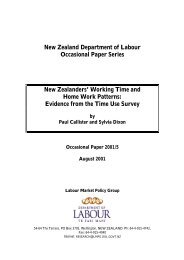

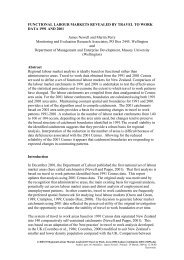
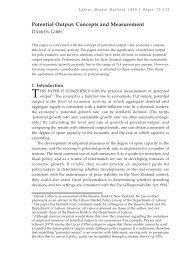

![a note on levels, trends, and some implications [pdf 21 pages, 139KB]](https://img.yumpu.com/27285836/1/184x260/a-note-on-levels-trends-and-some-implications-pdf-21-pages-139kb.jpg?quality=85)


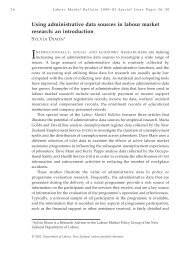


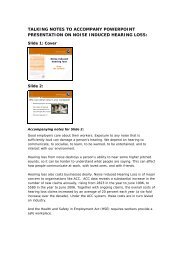
![Labour Market Trends and Outlook - 1996 [pdf 18 pages, 94KB]](https://img.yumpu.com/27285764/1/184x260/labour-market-trends-and-outlook-1996-pdf-18-pages-94kb.jpg?quality=85)
